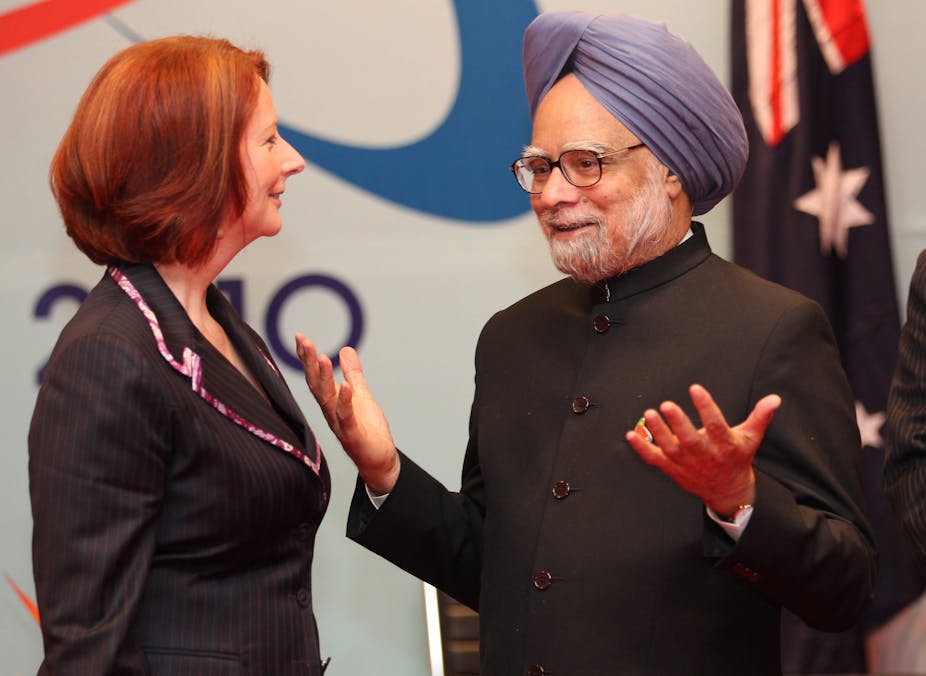Julia Gillard arrived yesterday in New Delhi for a three-day official visit. She’s there to promote Australia’s rising interest in India and seek greater economic, political and strategic links with that country. To that end, she will meet high profile political figures, business leaders and also highlight growing Australia-India cultural and social links.
Although she visited India in September 2009 as Deputy Prime Minister, this is her first visit as Prime Minister. During her 2009 visit, “racist attacks” on Indian students dominated India’s concerns, alongside clear diplomatic discomfort about the Rudd government’s reversal of the Howard government’s decision to sell uranium to India. On this visit, Gillard will urge the introduction of a uranium safeguards treaty, enabling uranium sales to begin.
India’s rising importance to Australia today stretches far beyond cricket and Commonwealth connections. Trade between the two nations has grown exponentially from about $3 billion at the turn of the century to more than $20 billion in 2011. This makes India Australia’s fastest growing export destination and fourth-largest export market, particularly in minerals and agricultural produce. Australia has also experienced a steady rise in direct investment from India, exceeding $11billion in 2011: mining is the top recipient.
India’s human face is today visibly present in almost all walks of life in Australia: transportation, service industry, retail, IT, engineering, education and the medicine. India was the largest source of migrants to Australia in 2011, exceeding traditional sources such as the United Kingdom, and Australia’s current migration policy sees the number of migrants from India set to rise. The lure of permanent migration heightens Australia’s appeal to Indian students, making India Australia’s number two source of overseas students after China, but with a sharp fall observed so far in 2012.
Gillard’s trip will be a boost for Australia’s case in India. Besides Prime Minister Manmohan Singh and President Pranab Mukherjee, she will meet two of India’s most powerful female political personalities: Sonia Gandhi, President of the Congress Party and party chief of the ruling coalition United Progressive Alliance (UPA) and Sushma Swaraj, opposition leader in the lower house of parliament. Discussion will range from education, trade and investment to regional and global concerns, prominently post-2014 Afghanistan.
High-level visits to India – all prime ministers from Howard onwards, many federal ministers and several state premiers have visited – put to rest concerns about Australian official neglect of India. Yet despite India’s commercial attraction and rising importance for Australia, the public’s knowledge of India drags at a historic low.
Australian universities used to boast of top historians of India and others well versed and deeply interested in India’s society, culture and politics. That stock has depleted and Australian universities have not committed necessary resources to build the next generation.
The Rudd government’s $8 million grant to the University of Melbourne to establish an Australia India Institute was prudent and far-sighted. But Australia now needs a medium to long-term strategy to build Indian studies and knowledge through establishing India programs in at least one university in each state, with active exchange and in-country programs with Indian universities.
The federal government will soon issue its white paper on Australia in the Asian Century. A blueprint for Australia’s engagement with Asia, it will argue for making Australia an Asia-literate society. Yet how – and indeed if – the government will commit the required resources to concrete policy action remains unclear.
Indian languages have been on the periphery of language learning in Australia. English is the language of communication in India, but serious research in India needs a working knowledge of Hindi and preferably a regional language. Similarly, business leaders and others with links in India will have deeper engagement and more productive, mutually satisfying outcomes only when they have some understanding of culture and ideally local language.
Australia has switched on to India, but is India reciprocating? The perception of “White Australia” still dominates the views of many, especially after the attacks on Indian students. Other concerns reach from perceptions of Australia’s arrogance over India’s nuclear testing in 1998 and Canberra’s more recent flip-flopping on uranium sales to India, to Australia’s obsession with China and its lack of an independent foreign policy through relying excessively on alliance with the US.
In India’s broader strategic frameworks, Australia remains on the periphery. Little wonder no Indian prime minister has visited Australia since Rajiv Gandhi in 1986. Part of Julia Gillard’s challenge this visit is to persuade her Indian counterpart to visit Australia to work towards more political symmetry in Australia–India relations.

